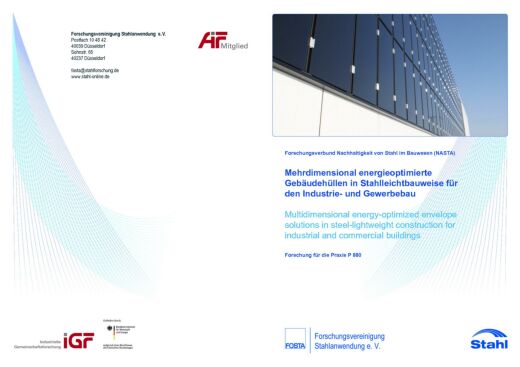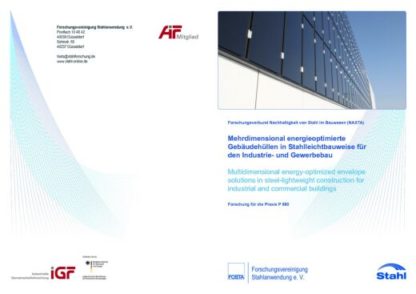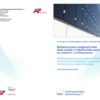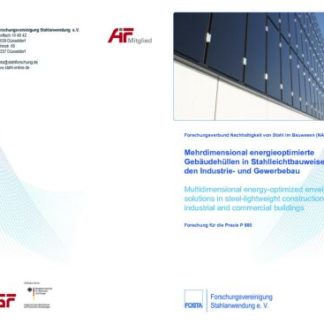Description
P 880 – Multidimensional energy-optimized envelope solutions in steel-lightweight construction for industrial and commercial buildings
Within the research project ways to optimize the energy consumption of building envelopes in lightweight steel construction were examined. The ability to use incident solar radiation for energy generation and the minimization of energy losses were objectives of the project. Since large surface potentials exist in industrial and commercial buildings, active use of solar gains is particularly promising in these areas. Moreover, optimizing (passive) physical properties enable great saving potentials. For minimizing the energy losses, the determining issues of heat transfer (cross section, thermal bridging,air tightness, design details) and durability (moisture protection) were analysed and researched due to optimization of energy consumption. By use of numerical and experimental methods, improved and conventional building systems in lightweight steel construction (sandwich, multi-layered structures) were examined and evaluated. The reduction of ventilation and heat transmission losses and also the prevention of condensation on and within structures were research objectives.
For power generation, innovative PV technology (flexible ball-film solar cells) has been applied to conventional sandwich panels. The influences of different profiles, as well as ways to integrate the module inter-connection into the panel, were examined. The gained results were compared technically-energetically and economically to the use of a sandwich panel with commercially available, additive PV modules. Another benefit results from the integration of solar thermal components. The outer cover plate of sandwich panels was used as solar collector to heat a fluid in pipes that are integrated behind the cover sheet. With the help of the developed FluidBox, a continuous series connection of several of these “solar thermal sandwich panels” was possible. The influence of various parameters, such as colour design, profiling and running of pipes or connections, was investigated numerically and experimentally.
So, the structure of the panel could be optimized by the integration of active components in order to minimize the (passive) energy losses. The energetic quality of building envelopes in lightweight steel construction were evaluated holistically in terms of sustainability criteria with the help of a reference hall. The results showed that savings for transmission and ventilation heat transfer can be realized by thermally improved sandwich constructions.
In the passive section, it was shown that some construction types cannot be used without restriction regarding the current energy requirements (transmission heat loss). For example, a conventional steel cassette construction with 3 mm separation strips energetically no longer represents the state of the art. The effect of a large amount of insulation material gets lost due to thermal bridging effects. Therefore, new solutions were developed conceptually, but further investigations are required. In addition, the influence of leaks in the building envelope on the energy loss has been clarified. By using building systems of lightweight steel construc-tion, a defect-free air tightness level can be achieved. But detailed theoretical planning and proper practical execution are required.
On the active side, it was illustrated, how the incident solar radiation can be used for energy issues. The investigated PV technology and the designed solar sandwich are solutions, which can be applied over a large area after integration into the continuous production process. Although the power generation by novel PV components are less efficient compared to the conventional additive systems, this deficiency can be compensated due to the larger surface and the unnecessary assembly.
The research project (IGF-Nr. 16586 N) was carried out at Lehrstuhl für Stahlbau und Leichtmetallbau der RWTH Aachen, at Lehr- und Forschungsgebiet Architektur + Metallbau der FH Dortmund, at Fachgebiet Umwelttechnik und Klimagerechtes Bauen, at Fachgebiet Umweltinformatik und Umweltmanagement der HTW Berlin and at Versuchsanstalt für Stahl, Holz und Steine, des Karlsruher Instituts für Technologie. FOSTA has accompanied the research project work and has organized the project funding from the Federal Ministry of Economics and Technology through the AiF as part of the programme for promoting industrial cooperation research (IGF) in accordance with a resolution of the German parliament.
Only available in german language.
Published in:
2016
Authors:
M. Feldmann, M. Kuhnhenne, D. Pyschny, M. Brieden, H. Hachul, J. Bach, H. Rößling, S. Rexroth, F. Deininger, R. Morana, R. Görner, T. Ummenhofer, T. Misiek, H. Krüger, C. Fauth




